The NVIDIA GeForce GTX 660 Review: GK106 Fills Out The Kepler Family
by Ryan Smith on September 13, 2012 9:00 AM ESTOC: Power, Temperature, & Noise
Before wrapping things up, we wanted to quickly take a look at the overclocking potential of the GTX 660. As the first GK106 product GTX 660 should give us some idea as to how capable GK106 is at overclocking, though like GK104 we’re eventually at the mercy of NVIDIA’s locked voltages and limited power target control.
In its rawest form, GTX 660 will have two things going against it for overclocking. First and foremost, as the highest clocked GK106 part it’s already starting out at a fairly high clockspeed – 980MHz for reference cards, and upwards of 1050MHz for factory overclocked cards – so there may not be a great deal of overclocking headroom left to exploit. Furthermore because NVIDIA is keeping the power consumption of the card low (it needs to stay under 150W max), the maximum power target is the lowest we’ve seen for any GTX 600 card yet: it’s a mere 110%. As a result even if we can hit a large GPU clock offset, there may not be enough power headroom available to let the GPU regularly reach those speeds.
Memory overclocking on the other hand looks much better. With the same memory controllers and the same spec’d RAM as on the other high-end GTX 600 cards, there’s no reason to believe that the GTX 660 shouldn’t be able to hit equally high memory clocks, which means 6.5GHz+ is a reasonable goal.
| GeForce GTX 660 Overclocking | ||||||
| Ref GTX 660 | EVGA GTX 660 SC | Zotac GTX 660 | Gigabyte GTX 660 OC | |||
| Shipping Core Clock | 980MHz | 1046MHz | 993MHz | 1033MHz | ||
| Shipping Max Boost Clock | 1084MHz | 1123MHz | 1110MHz | 1123MHz | ||
| Shipping Memory Clock | 6GHz | 6GHz | 6GHz | 6GHz | ||
| Shipping Max Boost Voltage | 1.175v | 1.175v | 1.162v | 1.175v | ||
| Overclock Core Clock | 1080MHz | 1096MHz | 1093MHz | 1083MHz | ||
| Overclock Max Boost Clock | 1185MHz | 1174MHz | 1215MHz | 1174MHz | ||
| Overclock Memory Clock | 6.7GHz | 6.9GHz | 6.7GHz | 6.5GHz | ||
| Overclock Max Boost Voltage | 1.175v | 1.175v | 1.162v | 1.175v | ||
Throwing in our factory overclocked cards from our companion roundup, our core overclocking experience was remarkably consistent. The difference in the max boost clock between the slowest and fastest card was a mere 41MHz, with the Zotac card being a clear outlier compared to the rest of our cards. This comes as no great surprise since all of these launch cards are using the NVIDIA reference PCB, so there’s little room at this moment for overclocking innovation.
Memory overclocking is as volatile as ever, with a 400MHz spread between our best and worst cards. Again with the use of the reference PCB (and the same Samsung RAM), memory overclocking is entirely the luck of the draw.
For the moment at least GTX 660 overclocking looks to be on a level playing field due to all partners using the same PCB. For overclockers the choice of a card will come down to pricing, what cooler they prefer, and any preference in vendor.
The end result of all of this is that at best we’re seeing 100MHz overclocks (going by the max boost clock), which represents roughly a 10% overclock. Coupling this with a good memory overclock and the 10% increase in the power target will result in around a 10% increase in performance, which isn’t shabby but also is the same kind of shallow overclocking potential that we’ve seen on cards like the GTX 670 and GTX 660 Ti. All told the GTX 660 isn’t a poor overclocker – 10% more performance for free is nothing to sneeze at – but it’s also not going to enamor itself with hardware overclockers who like to chase 20% or more.
Moving on to our performance charts, we’re going to once again start with power, temperature, and noise, before moving on to gaming performance. Due to popular demand we’ll also be including overclocking results with just a 110% power target so that you can see the impact of adjusting the power target separately from the clock offsets.
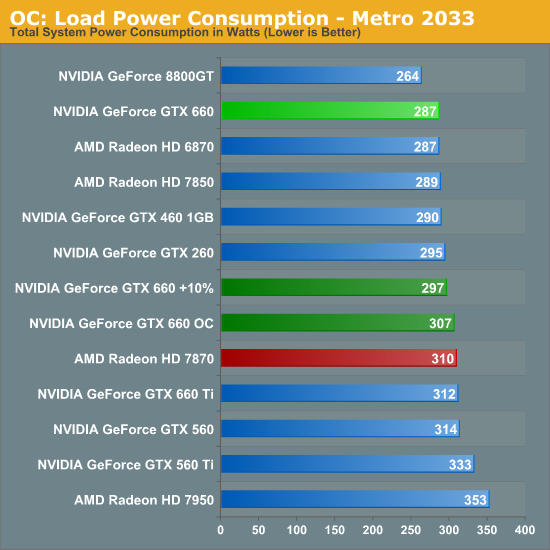
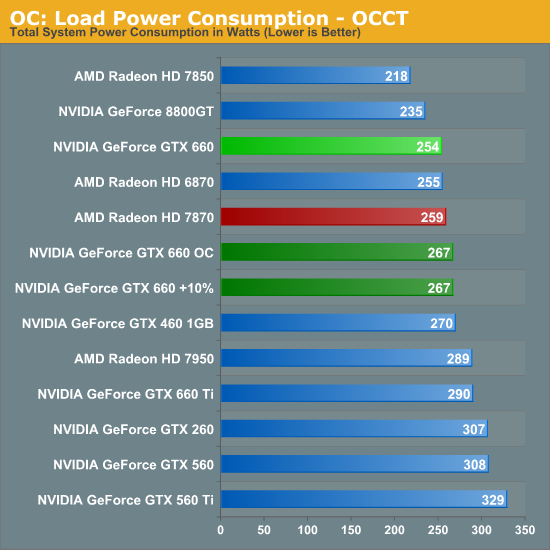
With a 110% power target we should be seeing an 11W-14W increase in power consumption, which is indeed roughly what we’re seeing at the wall after accounting for PSU inefficiencies. In Metro this is just enough of a difference to erase most of the GTX 660’s power consumption advantage over the GTX 660 Ti, though the GTX 660 still draws marginally less power than the stock 7870. Meanwhile under OCCT the GTX 660 now draws more power than the 7870, but still is still drawing over 20W less than the stock GTX 660 Ti.
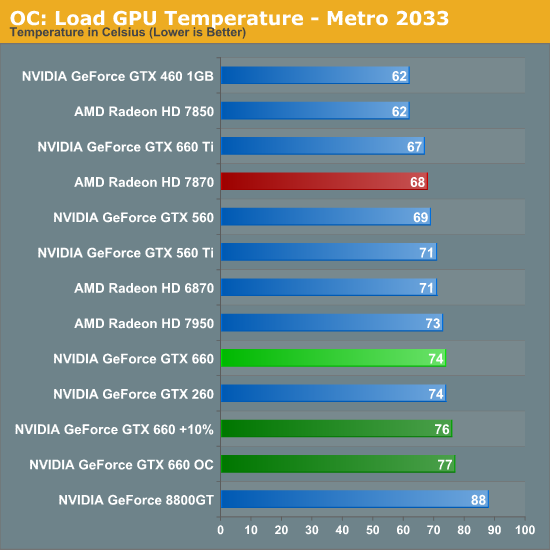
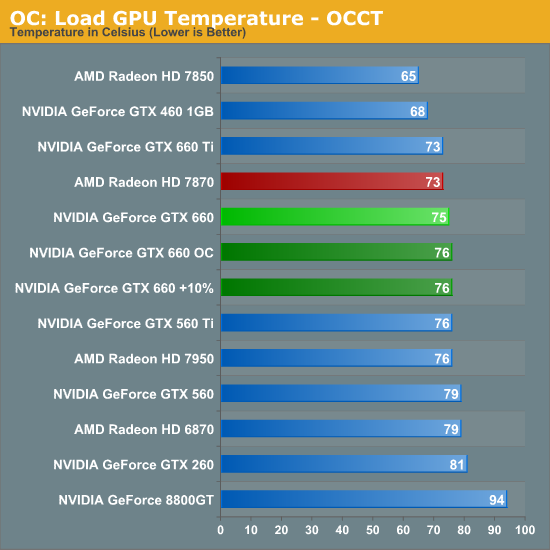
Our increased power consumption pushes temperatures up by another 2-3C. This is nothing a blower can’t handle, let alone an open-air cooler.
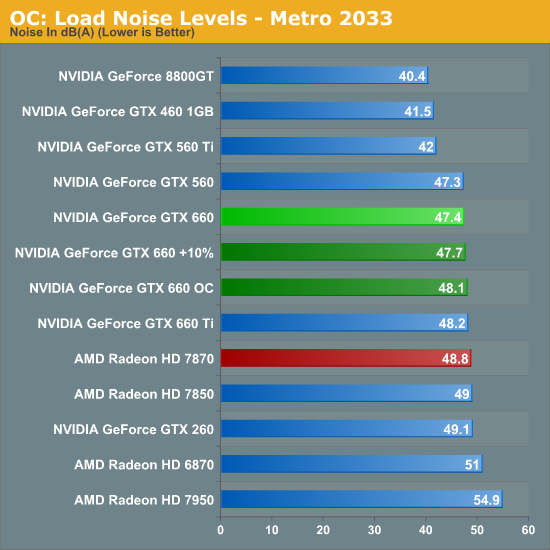
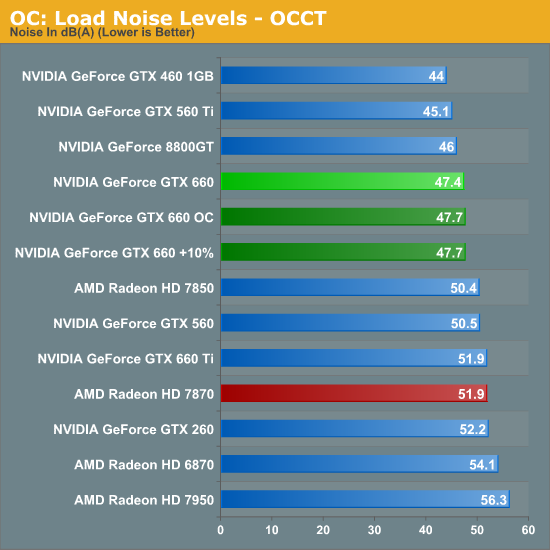
Interestingly enough, despite the increase in power consumption and temperatures, overclocking has almost no impact on noise. In the worst case scenario our GTX 660’s increased its fan speed by all of 2%, which increases noise by less than 1dB. As a result the amount of noise generated by the overclocked GTX 660 is practically identical to that generated by the stock GTX 660, and still below the reference 7870.










147 Comments
View All Comments
Jumangi - Thursday, September 13, 2012 - link
LOL way to try and spin AMD fanboy. The 660 is the equal of a 7870. It beats it in several tests and loses by a little in others. The $229 price is correct.Go qq somewhere else AMD dude.
Jamahl - Thursday, September 13, 2012 - link
Actually if you read anywhere else you'll find that the 7870 wins by 5-10% in the vast majority of cases.Samus - Thursday, September 13, 2012 - link
I'll take Anandtech reviews over any other reviews. This site has a 15 year reputation for truth.Jamahl - Thursday, September 13, 2012 - link
You do that. Most other people would take the average of all the reviews, and when they did that they'd realise that once again Anandtech is an outlier for Nvidia.rarson - Friday, September 14, 2012 - link
Anandtech lost that reputation years ago when everything started sounding pro-Intel/Nvidia/Apple.RussianSensation - Thursday, September 13, 2012 - link
Raghu78 is actually right."Overall the new ASUS GeForce GTX 660 DirectCU II seems to compete well with a price comparative factory overclocked Radeon HD 7870. While the gameplay experience is mostly the same between the two video cards, for the most part the factory overclocked Radeon HD 7870 seems to take the performance lead. If you look back at every game, the overclocked Radeon HD 7870 is on top in terms of raw performance,"
http://www.hardocp.com/article/2012/09/13/asus_gef...
Given that NV is 7 months late, all they did here was just barely match the price/performance of a 7 months old part. Hard to get excited about that when it's mid-September 2012 and HD8000 series isn't far off now.
HisDivineOrder - Friday, September 14, 2012 - link
Geforce 660 MSRP is $230. Radeon 7870 MSRP is $250. And if you're saying that the Geforce launch is unimpressive then you're probably ignoring the fact that AMD ignored price drops for the 78xx series cards for many, many months and only just when the info about the 660 and 660 Ti began to show up did they start aggressively lowering their pricing.So... what's impressive about nVidia's parts is that they brought competition which drove AMD to lower pricing so much you could today say there's nothing impressive about nVidia's pricing.
And that's what's impressive about it. You should be thanking nVidia for finally showing up to the competition.
Also, saying the "HD8000 series isn't far off now" is disingenuous if that line follows the same model as the 7000 series and staggers the launch so the low end comes midway through or at the end of 1Q 2013. We're not talking about the high end. We're talking about the mainstream variants.
And, if you truly believe your rhetoric, then AMD will price those parts as high or higher than the 78xx series showed up with in order to milk the market while nVidia's not able to keep up. So those cards again won't matter much since they won't be anywhere near the same price as these mid-$200 cards.
We don't even know if AMD won't milk this gen a while longer than they did prior generations because their strategy seems very different than the one they've used for quite a while. And with nVidia coming so late in this gen, AMD might see advantage in riding it out with parity and lower prices (while building up inventory of HD8k) to clean out their old stock.
Then one day after first quarter 2013, WHAM! HD8000 arrives in force. nVidia employees throughout the world look up from typing biased forum posts in every forum you visit and almost weep as cards in every bracket suddenly appear in the marketplace, but then a ray of hope shines through the darkness...
AMD priced everything high again. Angels sing and as Chuck Norris descends upon the clouds of awesomeness and badassness... GK110 arrives in his wake.
Ahhhh... I like this guessing game about what will happen with next gen thing.
raghu78 - Thursday, September 13, 2012 - link
buzz off . the majority of the reviews on the web show the HD 7870 to be faster.http://www.computerbase.de/artikel/grafikkarten/20...
http://ht4u.net/reviews/2012/nvidia_geforce_gtx_66...
http://www.hardware.fr/articles/876-21/recapitulat...
http://www.techpowerup.com/reviews/ASUS/GeForce_GT...
http://www.tomshardware.com/reviews/geforce-gtx-66...
http://www.hardocp.com/article/2012/09/13/asus_gef...
http://www.xbitlabs.com/articles/graphics/display/...
Margalus - Thursday, September 13, 2012 - link
I selected one random choice from your links, techpowerup. Guess what, the page you linked shows the 660 has higher performance per dollar than the 7870 at all resolutions except 2560x1600Galidou - Saturday, September 15, 2012 - link
Fun stuff, he said the ''majority'' and you look at only one of the links he sends. Replying the way you did is a little disrespectful. Next time just write: ''too long didn't read, this card ownz''.